Fish is Life is one of the leading players in Europe in the fresh, frozen, ultra low temperature and canned tuna markets.
Our experience of over 15 years and thorough knowledge of the fishing and processing sectors allow us meet your needs in terms of quality and pricing.
/ MAIN SPECIES
There are 5 main families of tuna, with Skipjack and Yellowfin making up over 80% of the total world tuna fishery (Skipjack 50% and Yellowfin 30%)..
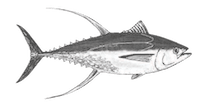
Yellowfin tuna
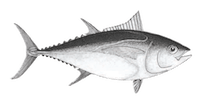
Bigeye tuna
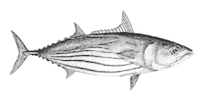
Skipjack tuna
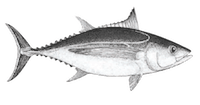
Albacore tuna
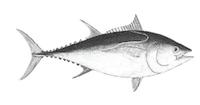
Bluefin Tuna
(marketed under stock sustainability guarantee)
/ main species
Tuna is one of the 2 most widely-sold seafood products in the world, with over 75% of the catch used by the canning industry and 25% for direct consumption (as fresh, frozen and ultra-low temperature). This distribution pattern is changing with each passing year in favor of direct consumption,which has enjoyed an increase of over 70% in the last 20 years.
Global distribution
The canning industry and Japanese direct consumption together account for over 90% of the world tuna market
Product description
Direct consumption of tuna is currently in full boom, with the rapid development of Japanese cuisine (sashimi and sushi) in Europe and in the U.S.
Sashimi is a traditional dish in Japanese cuisine, consisting of slices of raw fish.
Sushi is a rice preparation (with vinegar) rather than a fish preparation. There are 4 categories of sushi (Nigiri, Maki, Temaki & Oshizushi).
Tataki is a Japanese preparation method which consists of searing the tuna very quickly so that the heart remains raw.
Katsuobushi is the Japanese name for a preparation of dried, fermented and smoked skipjack tuna. It is one of the main ingredients in contemporary Japanese cuisine (miso soup, soba, etc …).
Tuna is mainly consumed in the form of cooked slices in Europe and the United States. As in the case of meat, when cooked it can be served "rare", "medium" or "well-done".
/ fishing methods
Tuna fishing can be divided into 3 main categories, the dominant type being Purse seine fishing, which accounts for over 60% of global volumes..

This technique involves the use of a long fishing line to which hooks are attached. In order to sink the line below the surface, a series of buoys and lead weights makes it possible to position the hooks at a depth of between 100 and 400 m (330 and 1310 ft). The long line may be up to 100 km (62 miles) in length. The daily catch is between 1,000 and 2,000 kg (including the by-catch).
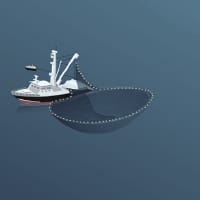
The seine net is a net that encircles a school of tuna at a depth of about 200 m (650 feet). The length of the largest nets is about 1.5 km (1 mile). The seine is a net that encircles the school of tuna at a depth of about 200m. The length of the largest nets is about 1.5km. In the case of a tuna seiner with a 1,500m net, a single seine haul can bring back 250 to 300 tonnes of fish. The "seine haul" lasts from 2 to 6 hours depending on the circumstances. You can do 4 of them per day. A tide lasts for one to two months to catch an average of about 1,000 tonnes of fish. In the case of a purse seiner fishing-boat with a seine net 1500 m. (4920 feet) in length, a single net operation can bring in from 250 to 300 metric tons of fish. A "seine net operation" lasts from 2 to 6 hours, depending on the circumstances. 4 operations of this kind can be carried out per day. In a fishing trip lasting one or two months, a purse seiner may catch about 1000 tons of fish.
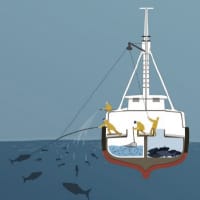
This fishing technique consists of capturing and keeping alive small fish such as sardines or anchovies that will be used as bait after sighting a school of tuna. The tuna are thus caught using fishing lines.
The aim is to attract the tuna as closely as possible to the boat and to keep them there by throwing live sardines or anchovies to them. Into this bait, the fishermen introduce barbless hooks on lines. The anglers can then strike their prey. Jets of water are directed at the surface of the water to simulate the wriggling of the sardines and to conceal the fishermen. The excited tuna are thus easier to catch. Daily catch levels: 5 metric tons per day.
/ NO HISTAMINE GUARANTEE
Histamine is a risk present in tuna. Our statistical analysis protocol allows us to guarantee our customers a level of risk close to zero.
What is histamine?
Histamine is a molecule that is naturally present in our bodies but which is also produced by bacterial activity in plants and animals containing histidine, an amino acid very close to histamine.
Histamine poisoning is a form of pseudo-food-allergy caused by the consumption of foodstuffs containing large quantities of histamine. The most frequently occurring symptoms are the presence of a red rash, hot flashes, a burning sensation in the throat, and itching and smarting of the skin. The symptoms usually appear rapidly (i.e., within a few hours or even minutes) and then disappear spontaneously in a few hours. Tuna is not the only foodstuff with a risk of histamine poisoning. The risk is also present, for example, with chocolate or Roquefort cheese, etc …
Factors leading to the development of symptoms
The proliferation of bacteria is the cause of the development of histamine in tuna.At each stage in the food-chain, any factor favoring the development of bacteria (such as the breaking of the cold chain) has an indirect effect on the development of histamine.
The development of histamine is significantly reduced between 0/5ºC (32/41ºF), and halted below 0ºC (32ºF). Thus, rapid storage in a refrigeration chamber and/or rapid freezing of the fish makes it possible to limit the risk of histamine developing.
Our first analysis policy
We have set up a statistical sampling and analysis system allowing us a 98% risk coverage. In France, we conduct systematic analysis of our imports for each batch purchased. In France, we carry systematic analysis on each imported lot.
In France, we conduct systematic analysis of our imports for each batch purchased.
/ ULTRA LOW TEMPERATURE CHANNEL (ULT)
We wish to reinstate the Tuna prestige by focusing on its colour, texture and flavour. We select ships that combine the following techniques for each fishing method: We select in each fishing method the vessels that combine the below techniques: :
Selective fishing enabling a better fish handling on board (longline, purse seine or pole & line)
Fast freezing on board ships
Ultra-low temperature storage
These specific criteria enable us to provide our customers a tuna (yellowfin, big eye and skip jack) with red colour meat, a firm texture and a typical taste of fresh tuna.
Selective fishing
We select fishing methods that encourage qualitative fishing:
Individual fishing or "small seine net" to ensure a quick handling of fish and to limit stress before being brought on board
Gentle transfer of fish on board to avoid bruises.
Fast killing according to the "sashimi" treatment developed by the Japanese.
These criteria can be adapted to seine fishing and long-line fishing.
Fast freezing
A fast freezing process allows for the conservation of the quality and texture of foodstuffs. Fast freezing preserves the quality and texture of foods. Indeed, tuna flesh is composed of 80% water. During freezing, the water molecules on the inside and outside of the cells transform into crystals that join with the neighbouring crystals. The slower the freezing, and the more the crystals join together to form larger ice crystals, the greater the risk of perforating the food cells. When a food cell is perforated, the liquid contained in the cell is released. The liquid will spread when the food eventually thaws. The cells also play a part in the texture of the food. The better they are preserved, the more the frozen food will be like fresh food after it thaws. Fish Is Life only selects ships with a pulsed air freezing capacity of -45°C or -60°C. The flesh of the tuna is in fact 80% water. During the freezing process, molecules of water inside and outside the cells are converted into crystals which then combine with the neighboring crystals. The slower the freezing process, the more the crystals join together to form larger and larger crystals of ice, thus running the risk of perforating the cells of the foodstuff. When the cell of a foodstuff is perforated, the liquid contained inside the cell is released once defrosted which affects the product texture. So the faster the freezing process, the more you will find the initial quality of the flesh after thawing.Fish Is Life only selects fishing vessels with a blast freezing capacity at -45 or -60°c.
ULT Storage on board ships
In order to better preserve the tuna colour and texture, we work with ultra-low temperature sashimi at -60°c and semi-sashimi at -40°c vessels. Respecting the temperature throughout the supply chain is an important key to product quality: Storage on board ships, Storage in the processing unit and packaging and Storage in France. Maintaining a constant low temperature throughout the supply chain is a key factor for the product quality: on board storage, storage in the processing and packing unit on land and the storage in France. Fish Is Life is one of the few European operators with dual temperature storage at -50°C (1,400 pallets) and -60°C (70 pallets).
Respecting the temperature throughout the supply chain is an important key to product quality: Storage on board ships, Storage in the processing unit and packaging and Storage in France.
Fish Is Life is one of the few European operators with dual temperature storage at -50°C (1,400 pallets) and -60°C (70 pallets).
Sustainable fishing
We ensure that all our shipowner partners comply with the RFMO (Regional Fishery Management Organisation) regulations and we work together with them to set up certifications such as MSC, FOS, etc.